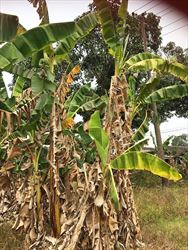- Narrow. Indonesia and Malaysia. Not recorded in Oceania.
- Major bacterial disease of banana - Musa acuminata, Musa bulbisiana, their hybrids, and Musa textalis. ABB and BBB cooking bananas especially susceptible. Information lacking on wild hosts.
- Symptoms vary depending on source of infection:
- (i) from soil : leaves yellow, wilt, collapse, and die. Internally, reddish-brown vascular staining, and white/yellow/red or black ooze.
- (ii) from flowers: fruit stem is invaded, flowers blacken, bell rots, fruits have internal rots, but remain green, and vascular tissues darken. Infections reach the corm, then leaf sheaths, and leaves turn brown, wilt and die.
- Spread: infected suckers, in soil, water, root-to-root contact; by insects (visiting male and female flowers); by pruning knives; from discarded infected fruit; mud on machinery/vehicles. Survival in soil for >1year.
- Biosecurity: risk is from unofficial introduction of diseased cuttings for propagation; possibly infected fruit; risk also from mud on vehicles. Official movement of germplasm should always follow the FAO/IPBGR Technical Guidelines.
- Biocontrol: none.
- Cultural control: take cuttings from apparently healthy plants, ideally from government scheme (if exist); avoid planting near diseased bananas; limit visitors/animals/workers to plantations; weed; remove male ‘bell’ after last hand emerges; bag flowers; clean tools frequently after use (bleach); remove diseased plants immediately, and contain spread with trench, leaving area fallow for 18 months or grow legume cover crop; clean soil from machinery/vehicles. Use local knowledge to select resistant varieties.
- Chemical control: not a method to use.









